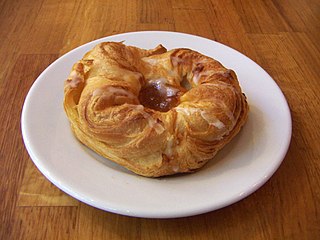
A Danish pastry is a multilayered, laminated sweet pastry in the viennoiserie tradition. It is thought that some bakery techniques were brought to Denmark by Austrian bakers, and originated the name of this pastry. The danish recipe is however different from the Viennese one and has since developed into a Danish specialty.
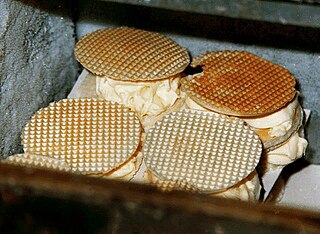
A wafer is a crisp, often sweet, very thin, flat, light biscuit, often used to decorate ice cream, and also used as a garnish on some sweet dishes. Wafers can also be made into cookies with cream flavoring sandwiched between them. They frequently have a waffle surface pattern but may also be patterned with insignia of the food's manufacturer or may be patternless. Some chocolate bars, such as Kit Kat and Coffee Crisp, are wafers with chocolate in and around them.

A hamantash is an Ashkenazi Jewish triangular filled-pocket pastry associated with the Jewish holiday of Purim. The name refers to Haman, the villain in the Purim story. In Hebrew, hamantashen are also known as אוזני המן, meaning "Haman's ears". "Haman's ears" also refers to a Sephardic Purim pastry, "Orejas de Haman", thought to originate in Spain and Italy, that is made by frying twisted or rolled strips of dough.
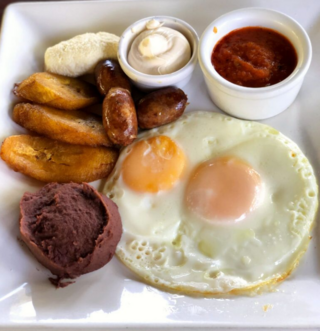
Salvadoran cuisine is a style of cooking derived from the nation of El Salvador. The indigenous foods consist of a mix of Amerindian cuisine from groups such as the Lenca, Pipil, Maya Poqomam, Maya Chʼortiʼ, Alaguilac and Cacaopera peoples. Many of the dishes are made with maize (corn). There is also heavy use of pork and seafood. European ingredients were incorporated after the Spanish conquest.

A melonpan is a type of Japanese sweetbun that is well known across the country and widely popular throughout China and Taiwan. The sweetbun is made from an enriched dough covered in a thin layer of crisp cookie dough. Their appearance resembles a melon, such as a rock melon (cantaloupe). They are not traditionally melon flavored, but in recent times, it has become popular for manufacturers to add melon flavoring to melon bread. Variations exist, including some with a few chocolate chips between the cookie layer and the enriched dough layer, and non-melon versions flavored with caramel, maple syrup, chocolate, or other flavors, sometimes with syrup, whipped or flavored cream, or custard as a filling. In the case of such variations, the name may drop the word "melon", instead replacing it with the name of the contents or may keep it despite the lack of melon flavor.

Biscocho, also spelled biskotso, refers to various types of Filipino twice-baked breads, usually coated with butter and sugar, or garlic in some cases. Biscocho is most strongly associated with the versions from the province of Iloilo, although it actually exists nationwide in various forms. It is also known as biscocho duro, machacao, or matsakaw. It is also historically known as pan de caña.
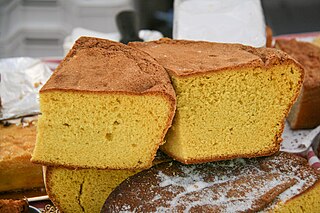
Bizcocho is the name given in the Spanish-speaking world to a wide range of pastries, cakes or cookies. The exact product to which the word bizcocho is applied varies widely depending on the region and country. For instance, in Spain bizcocho is exclusively used to refer to sponge cake. In Uruguay, most buttery flaky pastry including croissants are termed bizcocho, whilst sponge cake is called bizcochuelo. In Chile, the Dominican Republic and Bolivia bizcocho refers to a sweet dough (masa) baked with local ingredients, similar to the bizcocho from Spain. In Ecuador the dough of a bizcocho can either be sweet or salty. The US state New Mexico is unusual in using the diminutive form of the name, bizcochito, as the name for a locally developed and very popular cookie.

Pan de muerto is a type of pan dulce traditionally baked in Mexico and the Mexican diaspora during the weeks leading up to the Día de los Muertos, which is celebrated from November 1 to November 2.

Uruguayan cuisine is a fusion of cuisines from several European countries, especially of Mediterranean foods from Spain, Italy, Portugal and France. Other influences on the cuisine resulted from immigration from countries such as Germany and Scotland. Uruguayan gastronomy is a result of immigration, rather than local Amerindian cuisine, because of late-19th and early 20th century immigration waves of, mostly, Italians. Spanish influences are abundant: desserts like churros, flan, ensaimadas yoo (Catalan sweet bread), and alfajores were all brought from Spain. There are also all kinds of stews known as guisos or estofados, arroces, and fabada. All of the guisos and traditional pucheros (stews) are also of Spanish origin. Uruguayan preparations of fish, such as dried salt cod (bacalao), calamari, and octopus, originate from the Basque and Galician regions, and also Portugal. Due to its strong Italian tradition, all of the famous Italian pasta dishes are present in Uruguay including ravioli, lasagne, tortellini, fettuccine, and the traditional gnocchi. Although the pasta can be served with many sauces, there is one special sauce that was created by Uruguayans. Caruso sauce is a pasta sauce made from double cream, meat, onions, ham and mushrooms. It is very popular with sorrentinos and agnolotti. Additionally, there is Germanic influence in Uruguayan cuisine as well, particularly in sweet dishes. The pastries known as bizcochos are Germanic in origin: croissants, known as medialunas, are the most popular of these, and can be found in two varieties: butter- and lard-based. Also German in origin are the Berlinese known as bolas de fraile, and the rolls called piononos. The facturas were re-christened with local names given the difficult German phonology, and usually Uruguayanized by the addition of a dulce de leche filling. Even dishes like chucrut (sauerkraut) have also made it into mainstream Uruguayan dishes.

A palmier, pig's ear, palm heart, or elephant ear is a French pastry in a palm leaf shape or a butterfly shape, sometimes called palm leaves, cœur de France, French hearts, shoe-soles, or glasses that was invented in the beginning of the 20th century.
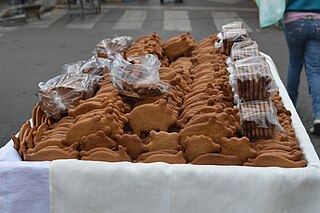
Cochinitos de piloncillo, also known as marranitos, cochinitos and puerquitos, are a typical Mexican sweet bread made with "piloncillo"—a type of sweetener made from sugar cane. Cochinitos are popular in bakeries in Mexico and throughout the US.

Mexican breads and other baked goods are the result of centuries of experimentation and the blending of influence from various European baking traditions. Wheat, and bread baked from it, was introduced by the Spanish at the time of the Conquest. The French influence in Mexican Bread is the strongest. From the bolillo evolving from a French baguette to the concha branching out from a French brioche even the terminology comes from France. A baño maría, meaning a water bath for a custard type budín or bread pudding comes from the French word bain marie. While the consumption of wheat has never surpassed that of corn in the country, wheat is still a staple food and an important part of everyday and special rituals. While Mexico has adopted various bread styles from Europe and the United States, most of the hundreds of varieties of breads made in the country were developed here. However, there is little to no baking done in Mexican homes; instead, Mexicans have bought their baked goods from bakeries since the colonial period.

Concha, plural conchas, is a traditional Mexican sweet bread roll. Conchas get their name from their round shape and their striped, seashell-like appearance. A concha consists of two parts, a sweetened bread roll, and a crunchy topping. Conchas are commonly found throughout Mexico in panaderias.

Camachile cookies, also known as quinamunsil, are Filipino ladyfinger cookies that are characteristically shaped like the fruits of the camachile tree. They are traditionally eaten with hot drinks for breakfast or merienda.































